Lasiospermum bipinnatum
Lasiospermum bipinnatum (Thunb.) Druce
Family: Asteraceae
Common names: ganskweek, gansbossie (Afr.); cocoonhead (Eng.)
Introduction
Lasiospermum bipinnatum is a prolific and showy perennial daisy with beautiful white-rayed flowerheads and aromatic leaves. Although it has been recorded as being used medicinally, it is best known for being toxic to livestock and so should used with care and only planted where there is no risk to livestock.
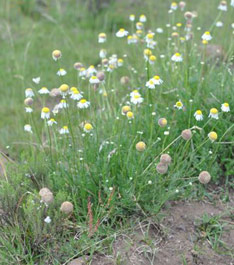
Description
Description
Lasiospermum bipinnatum is an erect to ascending, much branched perennial herb that grows up to about 0.6m high. It has bipinnatisect (twice-divided), glabrous leaves that have long sparse hairs when young.

The flower heads are heterogamous (flowers of different sex) with white outer ray florets and pale yellow inner disc florets. The flowerheads are borne singly on long glabrous peduncles (stalks). On warm sunny days the ray florets are horizontally positioned in relation to the flowerhead, becoming reflexed during cool periods of the day or at night and giving the flowerhead the appearance of a shuttlecock. It has green, ovate involucral bracts which are arranged in 3 or 4 overlapping rows around the flowerhead. The achenes (fruit) are dark yellow-brown in colour, with yellowish hairs, and lack a pappus (hairs or scales around the top of the fruit). The species flowers predominantly during late spring into summer.
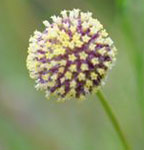
Conservation Status
Status
Lasiospermum bipinnatum is listed as Least Concern (LC) in the Red List of South African Plants (Raimondo et al. 2009).
Distribution and habitat
Distribution description
This species prefers moist areas, thriving in sandy, clayey and even dolorite substrates on mountains, flats, roadsides and disturbed and cultivated land of the Western, Eastern and Northern Cape, Free State, North-West, Gauteng and Lesotho.
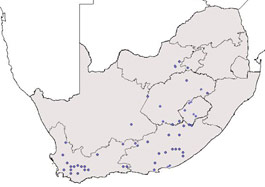
Derivation of name and historical aspects
History
This species was first collected and described by Carl Peter Thunberg in 1800. Thunberg, often referred to as "the father of South African botany", was a Swedish naturalist and student of Carl Linnaeus.
The genus name, Lasiospermum, is derived from the Greek words lasios, meaning shaggy, and sperma, meaning seed, and refers to the hairy fruits characteristic for the genus. The specific epithet bipinnatum refers to the conspicuously bipinnate (twice-divided) leaves.
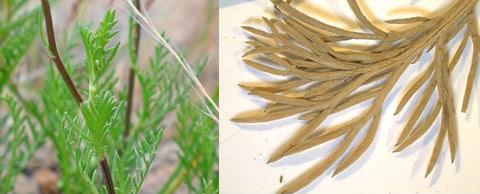
The genus comprises four southern African endemic species: L. bipinnatum , L. brachyglossum , L. pedunculare and L. poterioides, of which L. bipinnatum can be readily distinguished by the perennial habit and white-rayed flowers.
Ecology
Ecology
The plant produces phototoxic furanosesquiterpenoids which discourage grazers from eating them.
Uses
Use
Lasiospermum bipinnatum has been recorded as being used medicinally (Phillips 1917). An infusion of the plant is used for chest infections in the Middelburg district of the Eastern Cape. It is also used by the South-Sotho as an ointment to disinfect sickrooms. L. bipinnatum is also well known by farmers and veterinarians for its toxic properties. It has been reported to cause severe liver damage, icterus (yellowing of the skin and whitening of the eyes as result of liver infection), and photosensitivity (condition in which the skin becomes hyperreactive to sunlight) in sheep and cattle which have ingested it (Watt & Breyer-Brandwijk 1962). Due to its wide geographical distribution this species can affect a large percentage of sheep and cattle all over the country (Kellerman et al . 1973).
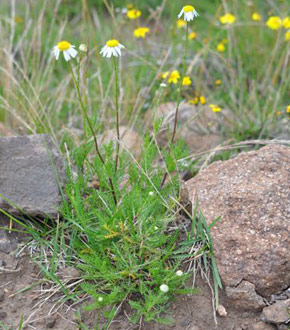
Growing Lasiospermum bipinnatum
Grow
This herbaceous perennial is widely planted in Kirstenbosch National Botanical Garden for its rich yellow-green foliage, showy flowerheads and its prolific flowering during late spring into summer. It should be borne in mind, however, that it does have toxic properties and so should be planted with caution in gardens where it may be ingested by small children or animals.
Lasiospermum bipinnatum is easily grown from cuttings that can be taken throughout the year. For optimum results, take cuttings of 30-70 mm length, dip the bases of these into a rooting hormone powder and plant in a 1:1 mixture of polystyrene and bark. These should then be left on a heated bench (to aid the rooting process) in a mist unit. Under these conditions rooting usually takes two to three weeks. If a heated bench is not available, the roots could be grown under normal conditions. An alternative medium can also be used, as long as it provides proper drainage.
If the seed is available, it should be sown in spring. Use a well-drained and level medium. Sow seed evenly and cover lightly with fine bark or river sand. Water lightly and do not allow the medium to dry out. Prick out the seedlings when they are large enough for transplanting into bags or directly into the garden.
In the garden, L. bipinnatum requires little attention but to prolong the flowering season it is advisable to continually remove any spent flowers. T he plants should also be severely pruned during autumn or winter to maintain their aesthetic shape and to remain floriferous. Plants can be kept in the garden for about two to three years, after which they should be replaced.
In larger gardens , L.bipinnatum makes for an excellent border plant and in smaller gardens it is well suited to mixed plantings. In gardens where summer annuals are extensively used, this plant is often used in combination with other perennials to provide colour and interest in the interim until the annuals come into flowers.
The ganskweek performs well with: Felicia echinata , F. dregei , Geranium incanum , G. multisectum , Lobelia valida , Cineraria saxifraga , Diascia species, Pelargonium ionidiflorum , Monopsis unidentata , Helichrysum cymosum and Arctotis arctotoides.
Photos: Anthony Magee
References
- Botha, C.J. & Penrith, M.L. (2008). Journal of Ethnopharmacology 119: 549-558.
- Kellerman, T.S., Basson, T.S., Naudé, T.W., Van Rensburg, I.B.J & Welman, W.G. (1973). Photosensitivity in South Africa. 1. A comparative study of Asaemia axillaris (Thunb.) Harv. ex Jackson and Lasiospermum bipinnatum (Thunb.) Druce poisoning in sheep. Onderstepoort Journal of Veterinary Research 40,3: 115-126.
- Muller, M.A.N., Herman, P.P.J. & Kolberg, H.H. (2001). A taxonomic revision of the genus Lasiospermum (Anthemideae-Asteraceae) in southern Africa. Flora of southern Africa 33,4: 64-68.
- Phillips, E.P. (1917). A contribution to the flora of the Leribe Plateau. Annals of the South African Museum 16,1: 1-379.
- Raimondo, D., Von Staden, L., Foden, W., Victor, J.E., Helme, N.A., Turner, R.C., Kamundi, D.A. & Manyama, P.A. (eds). (2009). Red List of South African Plants 2009. Strelitzia 25. South African National Biodiversity Institute, Pretoria.
- Trinder-Smith, T.H. (2003). The Levyns guide to the plant genera of the southwestern Cape. Contributions from the Bolus Herbarium No. 21.
- Watt, J.M & Breyer-Brandwijk, M.G. (1962). Medicinal and poisonous plants of southern and eastern Africa, edn 2. Livingstone, Edinburgh.
Credits
Bronwynne Busch, Roger Oliver & Anthony R. Magee
Compton Herbarium, Kirstenbosch NBG
June 2012
Plant Attributes:
Plant Type: Perennial
SA Distribution: Eastern Cape, Free State, Gauteng, North West, Northern Cape, Western Cape
Soil type: Sandy, Clay, Loam, Metal-rich
Flowering season: Spring, Early Summer, Late Summer
PH: Acid, Alkaline, Neutral
Flower colour: White
Aspect: Full Sun
Gardening skill: Easy
Special Features:
Horticultural zones











Rate this article
Article well written and informative
Rate this plant
Is this an interesting plant?
Login to add your Comment
Back to topNot registered yet? Click here to register.